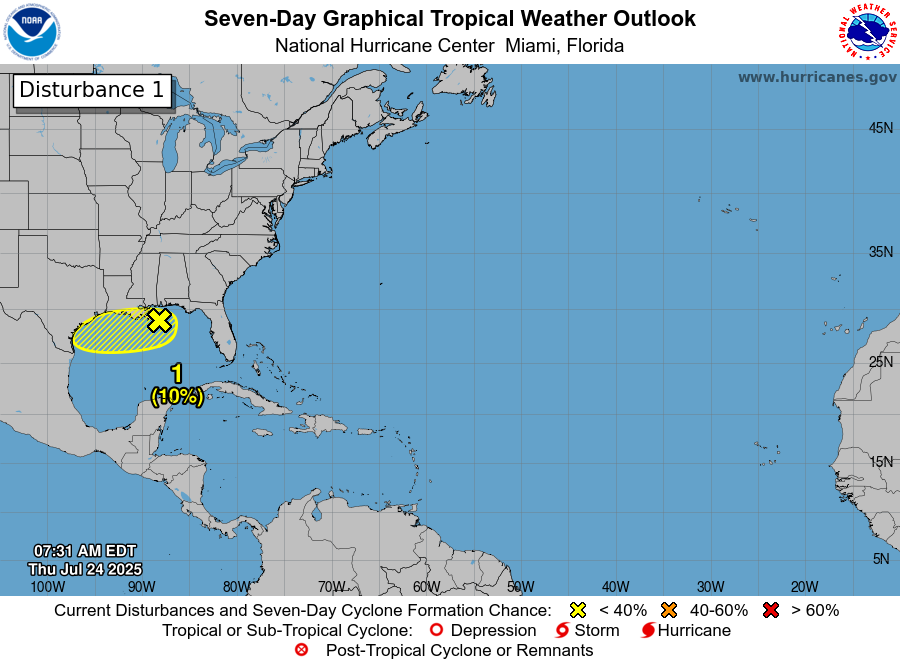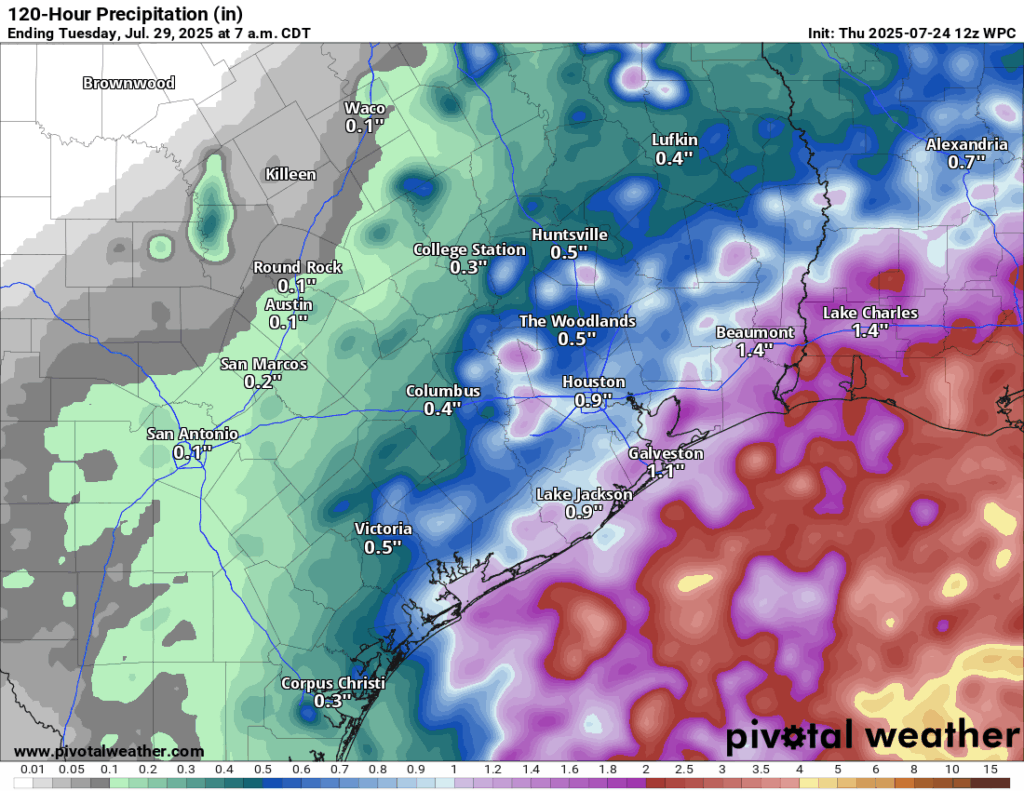In brief: The Gulf tropical disturbance is unlikely to develop, but it will bring some rain to the area tomorrow and Saturday. We have one more shot at 100 today before a brief break. More 100 chances return next week. Today we also dive into Bush Airport and talk about why it seemed to be such an outlier on Tuesday.
First, the tropics
Let’s start quickly this morning with the tropics and on this disturbance we have moving across the Gulf today and into our region tomorrow. There continues to be little to no chance of development with this. For Greater Houston, that means an increase in rain chances tomorrow and Saturday. And even that should be manageable.
Now, how much rain? Well, Friday will be interesting. It could go one of two ways I think. The first way? The disturbance approaches Texas and we get a solid rain shield offshore, so coastal areas see a fair bit of rain in the morning, with inland areas seeing just a few scattered afternoon thunderstorms. Alternatively, we see a small bit of rain in the morning at the coast and then more numerous showers and afternoon thunderstorms moving southeast to northwest across the region. I am leaning heavily toward the coastal rain outcome, where inland areas see some scattered storms but nothing too widespread. This means folks in Galveston could easily see a couple inches of rain, and more numerous showers and storms may push across Brazoria, Galveston, and Chambers Counties.
On Saturday, we’ll probably see a repeat, except I think storms could be more numerous across the entire region. As we’ve been saying, it should not be a total washout, but you’ll want to have some rain plans in place on both Friday and Saturday if you’re planning outdoor activities.
Rain totals will be on the order of probably 1 to 2 inches at the coast and a gradual trailing off of rain inland down to about a half-inch to inch inside the 610 Loop and less than that farther inland on average. Some areas may see little to no rain. Other isolated pockets, especially south and east of Houston could see 3 to 4 inches of rain.
Next, the heat
We hit 99 degrees yesterday, and we will make another run for 99 or 100 today probably. With clouds and showers around, Friday and Saturday should be substantially less hot. But look for the heat to return Sunday or Monday, and we will be making another run at 100 degrees by Tuesday or Wednesday.
Is the IAH thermometer rigged?
The fun thing about weather is that no matter where you live, if something looks the slightest bit suspicious, people start weighing in with lukewarm and hot takes about why there’s something wrong with a temperature sensor, someone has an agenda and is purposefully fudging data, and on and on. One of my favorites is when Washington, DC gets snow, virtually the entire city gets mad at whoever measures the snow at Reagan Airport because it is obviously too low. In Philadelphia, you get the opposite, the snow totals almost always get yelled at by people for being inflated.
Well, we’ve got ourselves a fun game of this happening in Houston now. On Tuesday, when IAH hit 100 degrees, many people were convinced it made no sense.
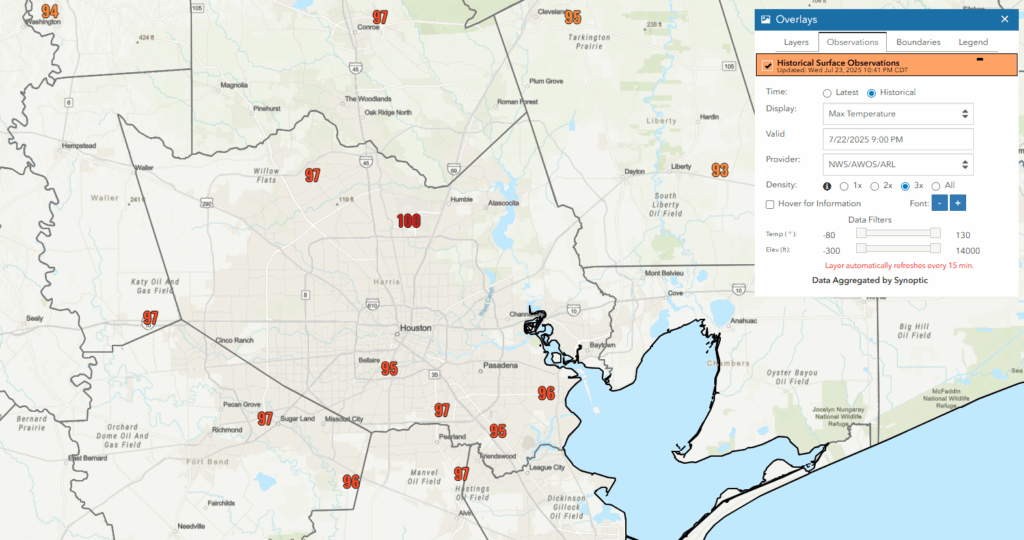
And, honestly, looking at that map above, I get it. IAH does stand out. Out of an abundance of caution, the NWS sent their electronics technician out to look at the thermometer at IAH. It was fine. It was reading where it should have been, and there have not been any recent changes near the thermometer. Turns out, it’s just hot at IAH. If you look at the high temperatures on Tuesday from a number of additional weather stations, filtered for most of the clearly bogus values (50s, 110s), you’ll see multiple spots hit 100 degrees.
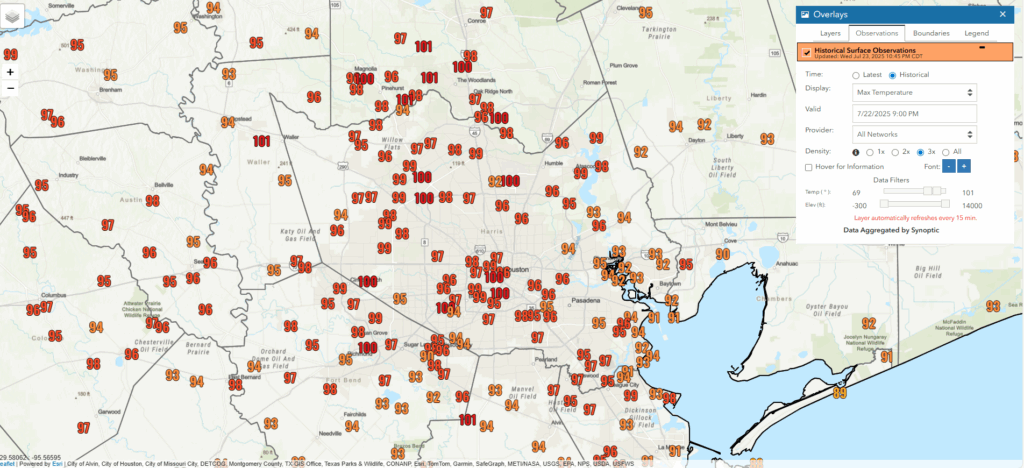
I’m not going to say that each of these weather sensors is sited perfectly or calibrated perfectly, but based on what I saw from sensors that I trust on Tuesday, I would have expected IAH to top off around 98-99 degrees. So, 100 doesn’t exactly shock me. But it’s definitely at the top end of temps for our area.
So, what is the deal with IAH, and can we trust it as a long-term indicator of our climate? It’s a complex and complicated question to answer. In most cities, historical data did move from essentially the center of town “back in the day” to airports. Official readings are now almost always taken at airports, where no one actually lives, of course.
A few places are unique or have complexities: Think Central Park in New York City; not an airport and a good, long historical data record. In Austin, you get to choose from Bergstrom Airport or Camp Mabry, two locations that can be very, very different during certain events. Downtown Los Angeles has also had a checkered history, with a weather station that has now moved 8 times. The linked article is from 2014, when USC housed the official Downtown L.A. sensor. It now sits on the south side of Dodger Stadium. The next time I visit SoCal, I intend to wear an Altuve jersey, go stand by it, and boo it. When stations like this move, there’s a process called “threading” that occurs. This process is by no means perfect, but it does a fairly good job of ensuring that station discontinuities are accounted for and the extremes we’re measuring against historically are as unified and realistic as possible.
Is IAH a reliable indicator of Houston’s weather history? Ten people will have ten opinions on this, but the reality is that it’s not really any worse than any other spot in the area. Houston is constantly evolving, growing, and changing. IAH isn’t perfect, but I think the important takeaway would be that there’s a difference between being representative of where people live versus being representative of reality at a given point. IAH isn’t a reliable indicator of every neighborhood’s weather history in Houston. But it is reliable as a location for our climatology today. In other words, compare IAH to IAH, not IAH to elsewhere. IAH hit 100 on Tuesday. Compared to previous records at IAH, it was one degree shy of a record high. That doesn’t mean that Sunnyside was 1 degree shy of a record. Or Sheldon was 1 degree shy of a record. IAH was. And since our official records are kept there, “Houston” was. You could make a similar argument about DFW Airport, which keeps Dallas’s official records or O’Hare in Chicago or Logan Airport in Boston.
Going back to the 100 on Tuesday, one of the key reasons for it may have been the lower humidity we saw that bubbled up in a pocket of the city. We can assess that with dewpoint values, as seen below. Also, IAH had 42% relative humidity at 3 PM, right around when it hit 100 degrees, which was one of the lowest relative humidity values in the city at that time.
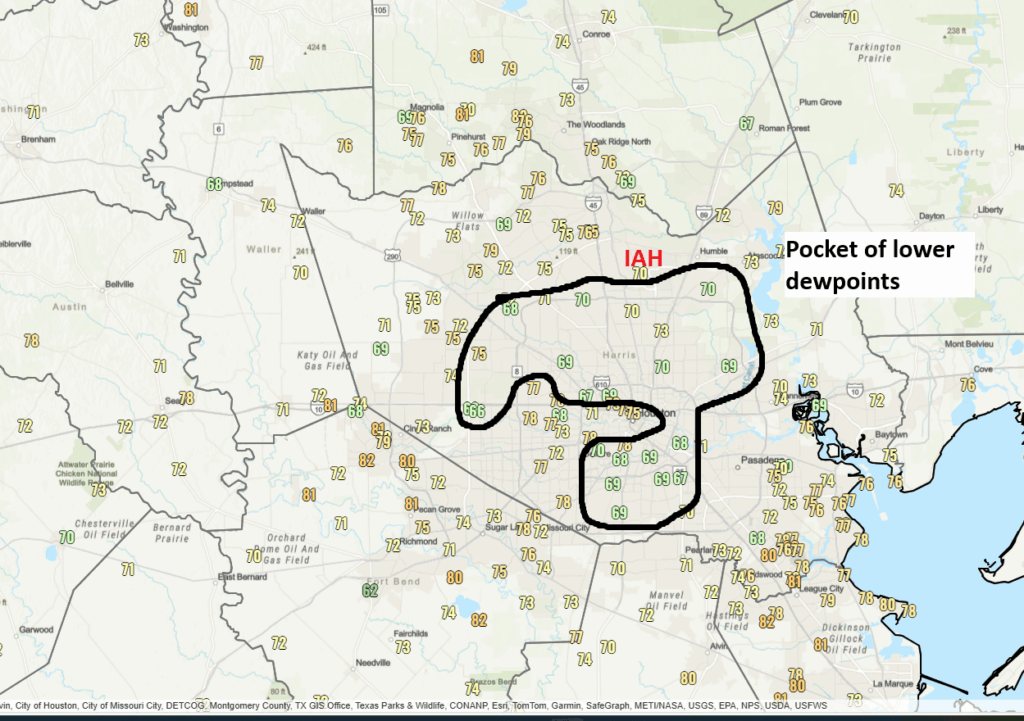
Drier air heats up more efficiently than more humid air, and when you have an air mass this hot, it doesn’t take a massive change in humidity to lead to a somewhat outsized change in temperature. Bottom line? It seems that a localized pocket of low humidity impacted the area near the airport. When combined with the already generally hot location of IAH, it led to a bump to 100 degrees on Tuesday, when most other locations were more like 96 to 98 degrees.
Does this settle the debate? Never. Everyone will still have opinions on this. Weather is a bit like sports in that regard, I guess. But when thinking of IAH, it’s a microcosm of all the things influencing our history here: Urban heat island, sprawl, a warming Gulf, and climate change all playing roles. But we wanted to share some of the plausible reasons why it happened, as well as add some color on IAH. Not perfect, but it’s what we’ve got.

